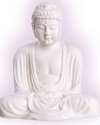"Don't forget that karate begins with a bow and ends with a bow." ~ Gichin Funakoshi
The word kara-te means "empty hand." When the occupying Japanese banned weapons in the 17th century, Okinawans created te turning their hands and feet into swords strong enough to crush the samurais' bamboo armor.
By 1901, the magic of karate, still an art taught in secrecy to a select few, began to be shared. Gichin Funakoshi (1868-1957), called the father of modern karate, brought Okinawan-Te to the mainland of Japan through his teaching and poetry.
Funakoshi said, "Seek perfection of character, be faithful, endeavor, respect others, and refrain from violent behavior."
He signed his poetry with the pen name Shoto, which means "small pine forest." His method of karate became Shotokan ("Shoto's School") and he believed karate routines—or kata—was an art, not a sport.
Through his poetry, Shoto was able to share spiritual values and education he felt necessary for karate...and life itself. With dedicated training and hard work, he taught humility and perfection of character and balance of the mind (shin), technique (gi), and body (tai).
"Do not think you have to win," he wrote, "think that you do not have to lose."
The art of karate is a celebration of positive attitude and high moral purpose. As karate master and film star Bruce Lee once advised, "Absorb what is useful, reject what is useless, and add what is specifically your own."
 How wonderful to begin and end with a bow!
How wonderful to begin and end with a bow!
